Spirit Airlines Bundle
Can Spirit Airlines Soar Again After Bankruptcy?
Spirit Airlines, the ultra-low-cost carrier, has undergone a dramatic transformation, emerging from Chapter 11 bankruptcy in March 2025. This pivotal moment marks a critical juncture for the airline, forcing a complete reassessment of its Spirit Airlines SWOT Analysis and overall business model. With significant financial challenges behind it, what is Spirit Airlines's future prospects and how will it navigate the competitive airline industry?
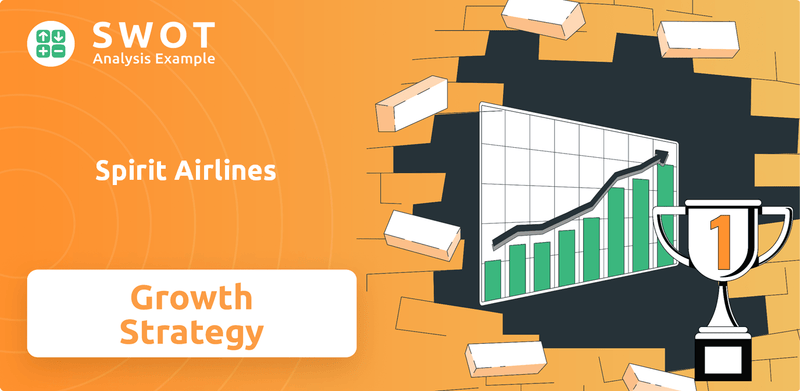
The airline's journey from bankruptcy to potential profitability is a compelling case study in strategic resilience. This analysis delves into Spirit Airlines's growth strategy, examining its expansion plans, cost-cutting measures, and strategic partnerships. We'll explore the key drivers of its future success, including its ability to enhance customer satisfaction and adapt to the evolving demands of the airline industry. Understanding Spirit Airlines's long-term investment strategy is crucial for anyone interested in the airline industry analysis.
How Is Spirit Airlines Expanding Its Reach?
Spirit Airlines is actively pursuing a multi-pronged expansion strategy. This involves optimizing its existing network, adding new routes to both domestic and international destinations, and forming strategic partnerships. The goal is to attract a broader customer base and increase its market share within the competitive airline industry.
A key aspect of this strategy is route network expansion. For instance, the airline plans to introduce numerous new routes in spring 2025, including services to Chattanooga, Tennessee, and Columbia, South Carolina. Simultaneously, it's working to enhance connectivity between existing destinations, such as the addition of 15 new routes from Detroit, starting in May or June 2025. This expansion highlights Spirit's commitment to growing its presence and providing more travel options for customers. The Competitors Landscape of Spirit Airlines shows how the airline is positioning itself in the market.
In March 2025, Spirit introduced new nonstop services from Chattanooga, Tennessee, and Columbia, South Carolina, and a new nonstop route connecting San Antonio and San Juan, Puerto Rico. Despite these additions, Spirit is also realigning its network. The airline plans to reduce capacity in all markets except Jamaica and increase it in the Peruvian market, though this is due to seasonal operations. Spirit is also exploring alliances with other carriers and redesigning its loyalty program to attract more customers.
Spirit Airlines is focusing on expanding its route network to include more domestic and international destinations. This strategy aims to attract a wider customer base and increase market share. New routes and enhanced connectivity are key components of this expansion.
The airline is making significant adjustments to its fleet. Spirit plans to reduce its fleet by 23 aircraft by the end of 2025. This includes the sale of older Airbus A320ceo and A321ceo models.
Spirit is exploring alliances with other carriers and redesigning its loyalty program. The company expanded benefits for active-duty U.S. military service members in 2024. These initiatives aim to enhance customer experience and attract more travelers.
The sale of older aircraft is expected to generate approximately $225 million in liquidity by the end of 2025. The airline has also deferred new aircraft deliveries scheduled from Q2 2025 through the end of 2026 until 2030-2031.
Spirit Airlines is actively managing its fleet to align with its financial and operational goals. This involves both reducing the number of aircraft and adjusting the timing of new deliveries. The strategy includes selling older aircraft and deferring new deliveries to improve financial stability.
- The airline plans to reduce its fleet by 23 aircraft by the end of 2025.
- The sale of older aircraft is expected to generate approximately $225 million in liquidity by the end of 2025.
- New aircraft deliveries scheduled from Q2 2025 through the end of 2026 have been deferred until 2030-2031.
- Spirit is slated to receive 28 new Airbus A320neo aircraft for delivery in 2026.
Spirit Airlines SWOT Analysis
- Complete SWOT Breakdown
- Fully Customizable
- Editable in Excel & Word
- Professional Formatting
- Investor-Ready Format
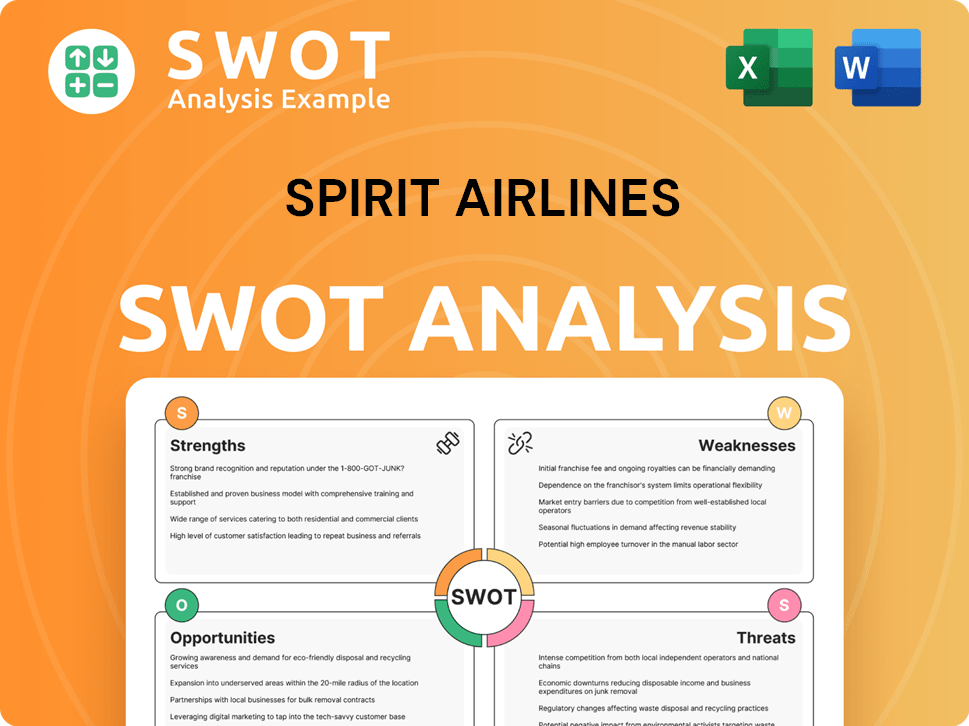
How Does Spirit Airlines Invest in Innovation?
Spirit Airlines is focusing on innovation and technology to boost operational efficiency, improve customer experience, and drive sustainable growth. This approach is crucial for the ultra-low-cost carrier to meet the evolving needs of modern travelers and stay competitive in the airline industry.
The company is investing in cutting-edge technology solutions, including mobile apps, self-service kiosks, and data analytics tools. This digital transformation is a key part of their strategy to streamline operations and enhance the overall travel experience. These efforts are part of the broader Mission, Vision & Core Values of Spirit Airlines.
A significant technological advancement is the planned rollout of Wi-Fi across its entire operational fleet by Fall 2025. This move aims to provide faster Wi-Fi than any other U.S.-based airline, using a new satellite system. Alongside connectivity, new seating options are being introduced, including a new extra-legroom seating option.
By Fall 2025, the entire fleet will have Wi-Fi. Free Spirit Gold members will get free Wi-Fi.
New seating product tiers are being introduced. An extra-legroom option will be available.
New airport lounge spaces are being introduced. Four new lounges will offer day pass options.
The Free Spirit loyalty program is being revamped. Updates will be effective from January 21, 2025.
Points can be redeemed for 'premium economy' level seating. Streamlined airport experiences with priority boarding are also included.
The airline is moving beyond its traditional ultra-low-cost model. The goal is to compete more effectively in premium market segments.
These initiatives show Spirit Airlines' commitment to enhancing its product offerings and guest experience. The airline is focusing on technology and innovation to improve its competitive position. These efforts are designed to attract a wider audience and retain travelers.
- Wi-Fi rollout across the fleet by Fall 2025.
- Introduction of new seating options, including extra legroom.
- New airport lounge spaces with day pass options.
- Revamped Free Spirit loyalty program with more value.
- Strategic shift towards premium market segments.
Spirit Airlines PESTLE Analysis
- Covers All 6 PESTLE Categories
- No Research Needed – Save Hours of Work
- Built by Experts, Trusted by Consultants
- Instant Download, Ready to Use
- 100% Editable, Fully Customizable
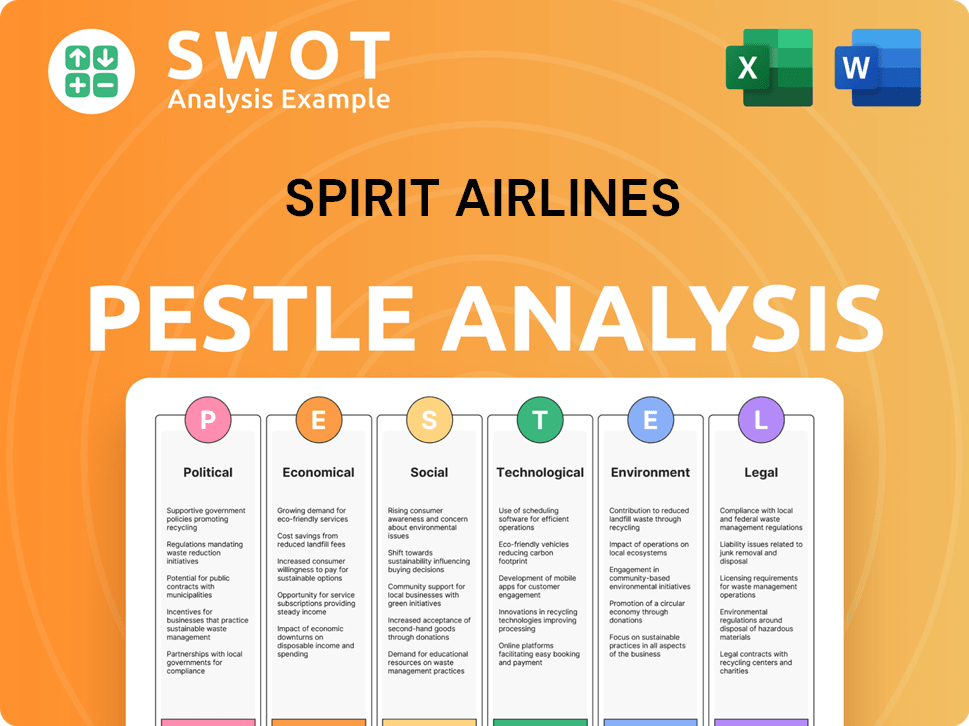
What Is Spirit Airlines’s Growth Forecast?
The financial outlook for Spirit Airlines has been significantly impacted by recent events. The ultra-low-cost carrier faced considerable challenges, leading to a Chapter 11 bankruptcy filing in November 2024. This filing underscored the severity of the financial difficulties the airline was experiencing, which included declining revenue and increased operational costs.
Spirit Airlines' financial performance in 2024 was marked by substantial losses. The airline reported a net loss of $1.2 billion, more than doubling the losses from the previous year. These struggles were compounded by the fact that Spirit hadn't been profitable since 2019, with losses exceeding $335 million in the first half of 2024 alone. This difficult period highlights the critical need for a robust Spirit Airlines growth strategy to stabilize its financial position.
Despite the challenges, Spirit Airlines has taken steps to restructure and recover. The company emerged from bankruptcy in March 2025, having completed its financial restructuring. As part of this process, Spirit received a $350 million equity investment from existing investors. Additionally, $300 million in Debtor-in-Possession (DIP) financing from bondholders was secured to help manage operations during the restructuring. These measures are designed to reduce debt and improve financial flexibility, which is crucial for the airline's future prospects.
Spirit Airlines completed its financial restructuring and emerged from bankruptcy in March 2025. This involved receiving a $350 million equity investment and securing $300 million in DIP financing. These investments are vital for supporting operations and future initiatives as the airline works to stabilize its finances.
The restructuring aims to reduce $795 million in funded debt, easing the burden of interest payments. Spirit is also implementing cost-saving measures, which are expected to provide benefits exceeding $75 million in 2024, with annual run-rate savings surpassing $100 million. These measures are part of a broader effort to improve the airline's financial performance.
Analysts project a modest improvement for Spirit in 2025, following a challenging 2024. S&P Global Ratings anticipates improved profitability with adjusted EBITDA margins around 7.5% in 2025. However, an unadjusted free cash flow deficit of about $270 million is still projected. These projections highlight the ongoing need for effective strategies to boost revenue and manage costs.
In Q1 2024, Spirit's operating revenues decreased by 6.2%, totaling $1,265.5 million, with a loss of $1.46 per share. Despite these figures, strategic and tactical adjustments positively influenced unit revenue. The company is focusing on operational efficiencies and strategic changes to improve its financial position and compete effectively in the airline industry.
Spirit expects to end 2024 with over $1 billion in liquidity, providing a financial cushion as it navigates its recovery. The focus is on returning to profitability through various strategic initiatives. The airline is working to implement a sustainable Spirit Airlines business model to ensure long-term viability.
The airline industry analysis indicates a highly competitive environment. Spirit Airlines faces challenges in maintaining and growing its market share. Understanding the competitive landscape and adapting its strategies will be crucial for long-term success. For a deeper dive into the company's history, consider reading the Brief History of Spirit Airlines.
Spirit Airlines Business Model Canvas
- Complete 9-Block Business Model Canvas
- Effortlessly Communicate Your Business Strategy
- Investor-Ready BMC Format
- 100% Editable and Customizable
- Clear and Structured Layout
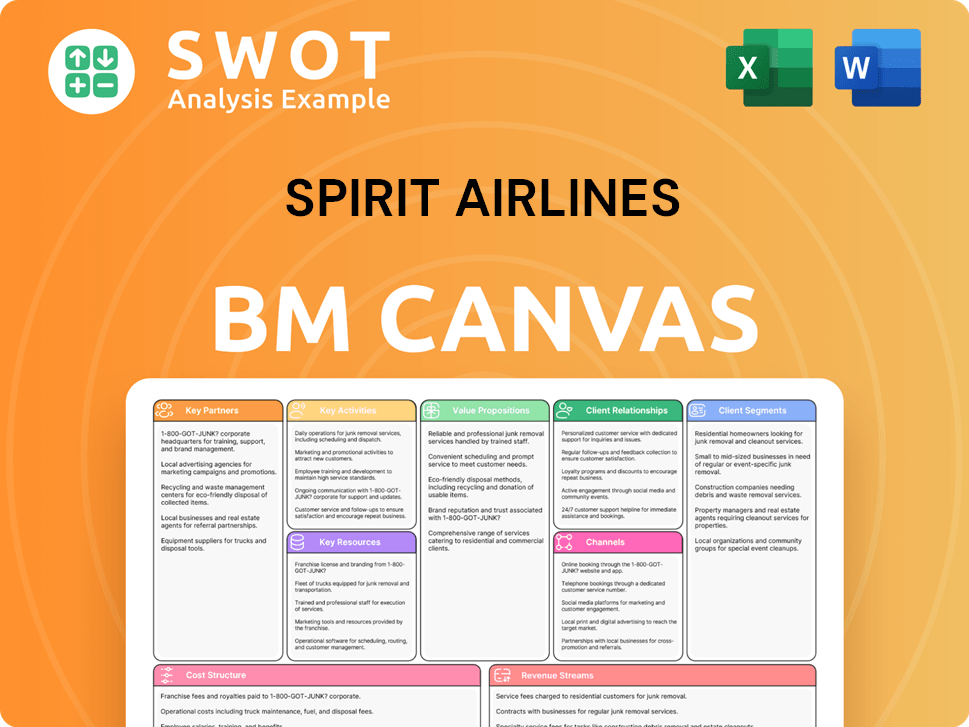
What Risks Could Slow Spirit Airlines’s Growth?
The path forward for Spirit Airlines is fraught with challenges, especially following its Chapter 11 bankruptcy filing in November 2024. The airline's growth strategy faces significant hurdles, including operational disruptions, intense competition, and financial pressures. Understanding these potential risks is crucial for assessing the airline's future prospects and its ability to navigate a complex industry.
A major obstacle is the ongoing Pratt & Whitney engine recall, which has grounded a substantial portion of its fleet. This, coupled with a challenging pricing environment expected to persist through at least the remainder of 2025, puts additional strain on the company. The airline's ability to maintain its ultra-low-cost carrier status and rebound from financial difficulties will be critical.
The airline industry is highly competitive, with Spirit facing intense competition from larger airlines with greater resources. The failed merger attempts with Frontier Airlines and JetBlue Airways, with the latter being blocked by a federal judge on antitrust grounds, were significant blows to Spirit's competitive position and financial stability. These missed opportunities for synergies and cost savings, coupled with increased competition, have exacerbated its financial troubles.
The Pratt & Whitney engine recall has grounded numerous Airbus A320neo jets, severely limiting operational capacity. Engine removals are projected to continue through 2026, contributing to persistent operational strain. The airline secured $150 million in credits related to aircraft unavailability through the end of 2024 from International Aero Engines (IAE), an affiliate of Pratt & Whitney.
Spirit faces intense competition from larger airlines with greater resources. The failed merger attempts with Frontier and JetBlue hindered its ability to compete effectively. This competitive environment, combined with missed opportunities for cost savings, has significantly impacted its financial stability.
Volatile fuel costs, rising labor expenses, and regulatory changes threaten its low-cost structure. The company's lack of fuel hedging since 2015 makes it vulnerable to price increases. Regulatory risks are substantial, as Spirit is subject to extensive regulations by the FAA, DOT, TSA, and other agencies.
Dependence on high aircraft utilization rates makes Spirit vulnerable to disruptions from weather and air traffic control. An aging fleet will require increased maintenance, potentially impacting financial performance. Lack of marketing alliances limits competitiveness on international routes. The restructuring process itself is consuming management's attention.
The company is navigating a 'challenging pricing environment' expected to persist at least through 2025. Tariffs on imported aircraft and parts could materially affect the company's financial condition. The restructuring process itself is consuming management's attention, potentially affecting business operations and increasing employee attrition.
Spirit is focusing on network optimization and seasonal route adjustments to maintain operational efficiency. The company is also implementing a transformation plan to improve revenue production and profitability, including new premium fare options and cost savings initiatives. Despite these challenges, Spirit has demonstrated operational improvements, achieving a 99.9% completion factor.
The airline industry is highly competitive, with significant market share held by larger carriers. Target Market of Spirit Airlines shows that Spirit's ultra-low-cost carrier business model faces constant pressure from both established and emerging competitors. The airline's market share is subject to fluctuations based on economic conditions, fuel prices, and operational efficiency.
Since 2015, Spirit has not engaged in fuel hedging, exposing it to volatile fuel costs. This strategy, while potentially beneficial in some periods, has left the company vulnerable to price spikes. Increased labor costs and regulatory changes also pose risks to the financial performance, potentially affecting profit margins.
Spirit Airlines Porter's Five Forces Analysis
- Covers All 5 Competitive Forces in Detail
- Structured for Consultants, Students, and Founders
- 100% Editable in Microsoft Word & Excel
- Instant Digital Download – Use Immediately
- Compatible with Mac & PC – Fully Unlocked
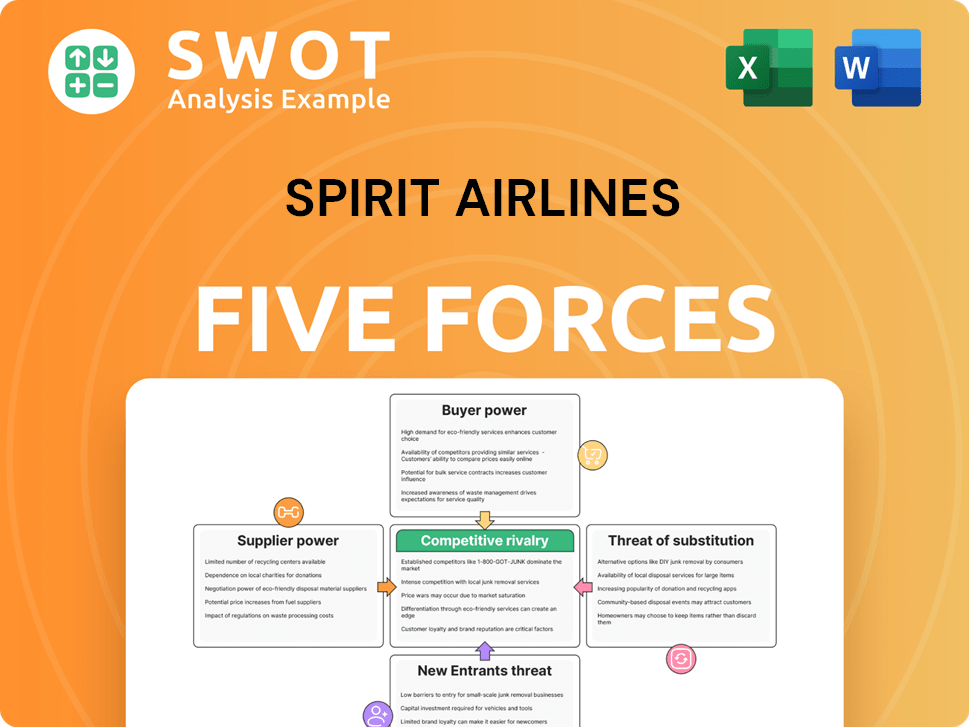
Related Blogs
- What are Mission Vision & Core Values of Spirit Airlines Company?
- What is Competitive Landscape of Spirit Airlines Company?
- How Does Spirit Airlines Company Work?
- What is Sales and Marketing Strategy of Spirit Airlines Company?
- What is Brief History of Spirit Airlines Company?
- Who Owns Spirit Airlines Company?
- What is Customer Demographics and Target Market of Spirit Airlines Company?
Disclaimer
All information, articles, and product details provided on this website are for general informational and educational purposes only. We do not claim any ownership over, nor do we intend to infringe upon, any trademarks, copyrights, logos, brand names, or other intellectual property mentioned or depicted on this site. Such intellectual property remains the property of its respective owners, and any references here are made solely for identification or informational purposes, without implying any affiliation, endorsement, or partnership.
We make no representations or warranties, express or implied, regarding the accuracy, completeness, or suitability of any content or products presented. Nothing on this website should be construed as legal, tax, investment, financial, medical, or other professional advice. In addition, no part of this site—including articles or product references—constitutes a solicitation, recommendation, endorsement, advertisement, or offer to buy or sell any securities, franchises, or other financial instruments, particularly in jurisdictions where such activity would be unlawful.
All content is of a general nature and may not address the specific circumstances of any individual or entity. It is not a substitute for professional advice or services. Any actions you take based on the information provided here are strictly at your own risk. You accept full responsibility for any decisions or outcomes arising from your use of this website and agree to release us from any liability in connection with your use of, or reliance upon, the content or products found herein.